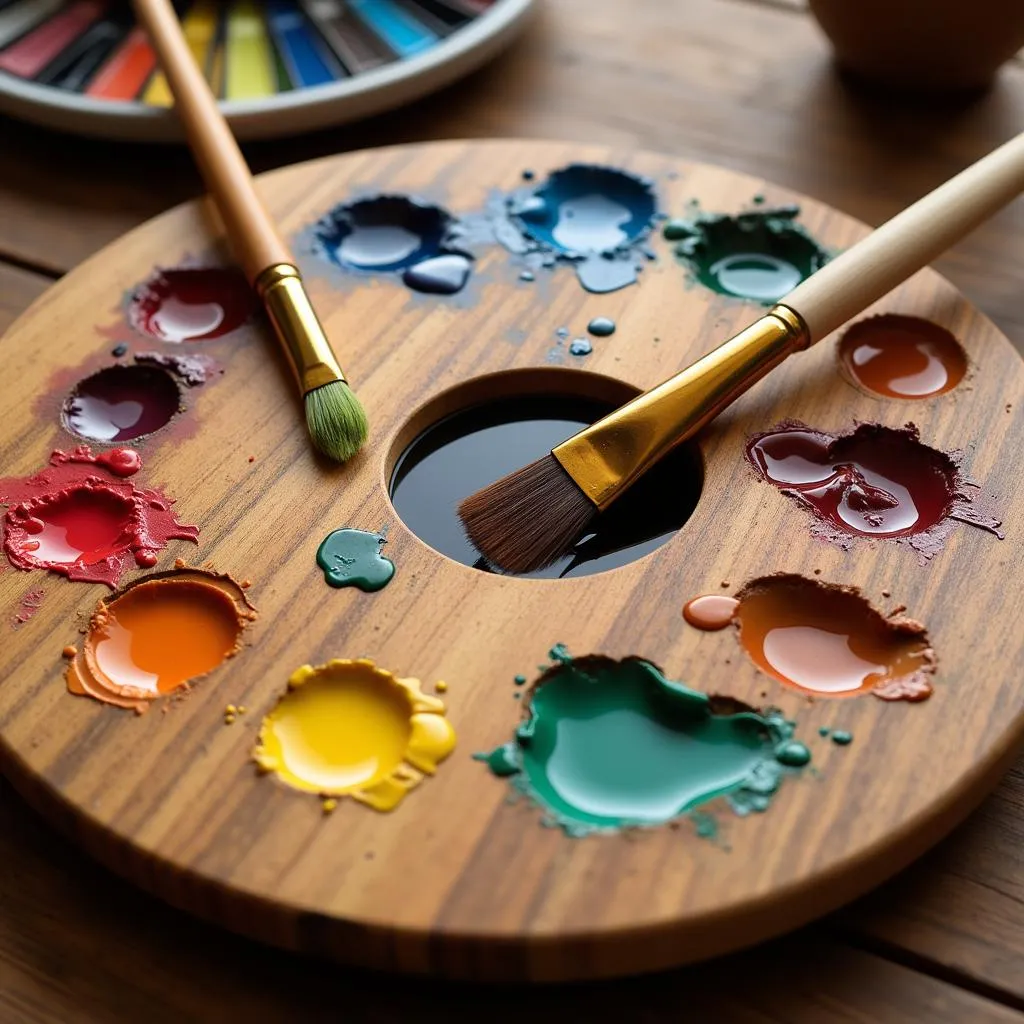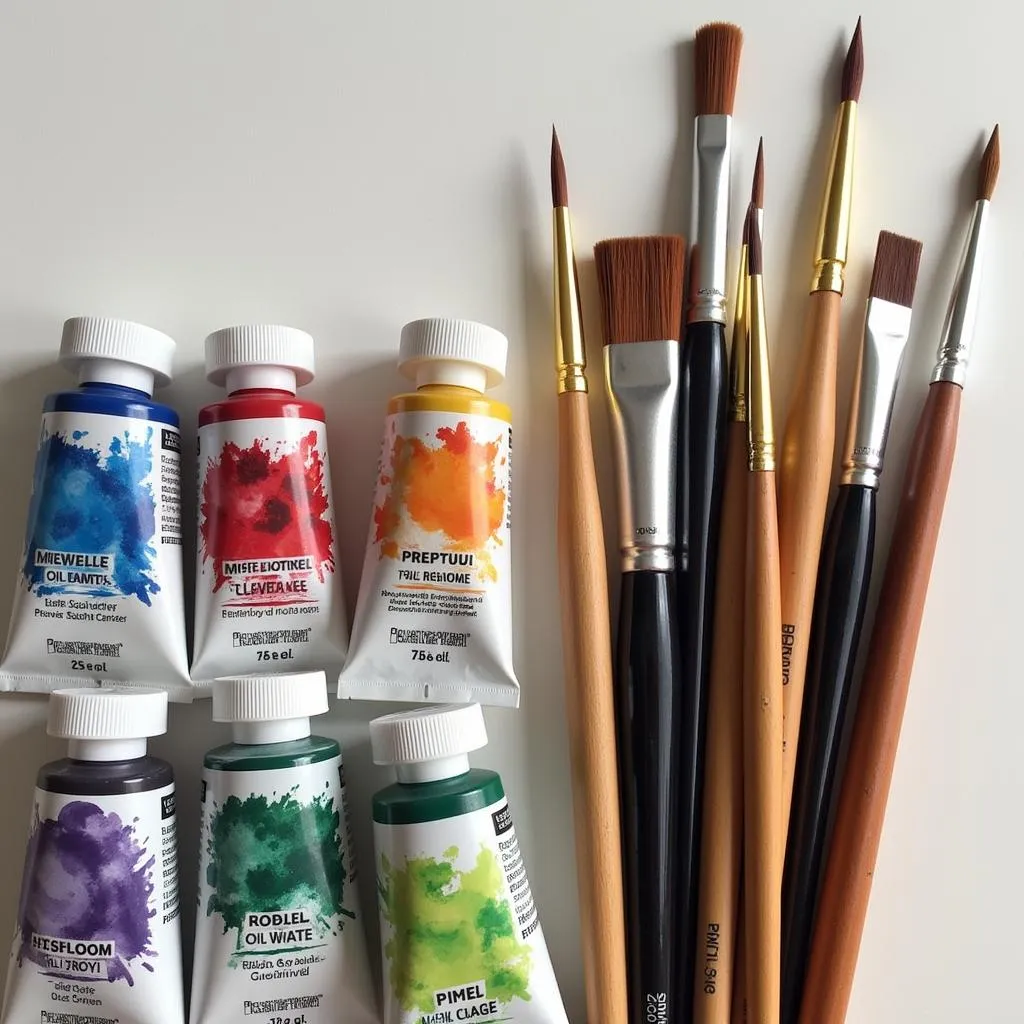Mixing oil colors is a fundamental skill that opens up a world of possibilities for artists of all levels. By understanding the principles of color theory and using the right techniques, you can create an infinite spectrum of hues and shades to bring your artistic visions to life. Whether you’re a seasoned painter or just starting out, mastering the art of oil color mixing can elevate your artwork to new heights.
 Oil color mixing palette
Oil color mixing palette
Understanding the Color Wheel
The foundation of successful color mixing lies in understanding the color wheel. This essential tool visually represents the relationships between different colors, guiding you in creating harmonious blends and achieving desired effects.
Primary Colors: The Building Blocks
At the heart of the color wheel are the primary colors: red, yellow, and blue. These pure pigments cannot be created by mixing other colors and serve as the foundation for all other hues.
Secondary Colors: Mixing Primaries
Combining any two primary colors in equal proportions yields a secondary color. Red and yellow create orange, yellow and blue make green, and blue and red produce violet.
Tertiary Colors: Expanding the Spectrum
Tertiary colors result from mixing a primary color with an adjacent secondary color. These combinations, such as red-orange, yellow-green, and blue-violet, offer a wider range of hues and subtle variations.
Essential Oil Color Mixing Techniques
Mastering a few key techniques will empower you to mix oil colors with confidence and precision.
1. Start with a Limited Palette
While it’s tempting to use every color in your arsenal, starting with a limited palette can be incredibly beneficial, especially for beginners. Focusing on a few key colors allows you to develop a deeper understanding of their interactions and create harmonious compositions. A classic limited palette includes:
- Warm Red: Cadmium Red Light or Vermilion
- Cool Red: Alizarin Crimson
- Warm Yellow: Cadmium Yellow Light or Yellow Ochre
- Cool Yellow: Lemon Yellow
- Warm Blue: Ultramarine Blue
- Cool Blue: Phthalo Blue
- White: Titanium White
- Black: Ivory Black
2. Gradually Add Color
When mixing oil colors, patience is key. Always start with the lighter color and gradually add the darker color in small increments until you achieve the desired hue. This gradual approach gives you greater control over the mixing process and prevents you from overshooting your target color.
3. Use a Palette Knife
While you can certainly mix colors directly on the canvas, using a palette knife offers several advantages. A palette knife allows for more precise color measurement and blending, resulting in cleaner, more vibrant mixtures. Additionally, a palette knife helps preserve the integrity of your brushes and prevents color contamination.
4. Consider Color Temperature
Color temperature plays a crucial role in creating harmonious and visually appealing paintings. Warm colors, such as reds, oranges, and yellows, tend to advance in a composition, while cool colors, like blues, greens, and violets, recede. By balancing warm and cool colors within your artwork, you can create depth, dimension, and visual interest.
5. Experiment and Explore
The beauty of oil painting lies in its versatility and endless possibilities. Don’t be afraid to experiment with different color combinations, mixing techniques, and application methods. Embrace the process of discovery and allow yourself to make mistakes—it’s all part of the learning journey.
Common Oil Color Mixing Challenges and Solutions
Even experienced artists encounter challenges when mixing oil colors. Here are a few common issues and practical solutions:
Challenge: Creating muddy or dull colors.
Solution: Ensure you’re using high-quality pigments and avoid overmixing the colors. Start with a limited palette and gradually add colors until you achieve the desired hue.
Challenge: Achieving consistent color mixtures.
Solution: Use a consistent light source when mixing your colors, as different lighting conditions can affect how colors appear. Additionally, make notes or take photos of your successful color recipes for future reference.
Challenge: Matching colors accurately.
Solution: Practice your color matching skills by attempting to replicate colors from real-life objects or photographs. Develop your eye for subtle color variations and learn to identify the underlying hues within complex colors.
Tips for Mixing Specific Colors
While the possibilities are endless, here are a few tips for mixing some commonly desired colors:
- Mixing browns: Combine complementary colors, such as red and green, blue and orange, or yellow and purple. Adjust the ratios to achieve different shades of brown.
- Mixing grays: Mix black and white, or experiment with combining complementary colors in varying proportions. Adding a touch of blue to a gray mixture can create a cooler, more atmospheric gray. You can learn more about mixing colors in our guide: what colors make different colors.
- Mixing greens: Combine yellow and blue. Use more yellow for a warmer green, or more blue for a cooler green. For a vibrant purple, check out our guide on which colors make purple.
 Oil paints and brushes
Oil paints and brushes
Conclusion
Mastering the art of how to mix oil colors is an ongoing journey of exploration and discovery. By understanding the principles of color theory, practicing essential techniques, and embracing experimentation, you can unlock a world of creative possibilities and bring your artistic visions to life with vibrancy and depth. Remember, every brushstroke is an opportunity to learn and grow as an artist.
FAQs
1. What is the best way to clean oil paint brushes?
Use a solvent like turpentine or mineral spirits to remove the paint, then wash the brushes with soap and water.
2. How long does it take for oil paint to dry?
Oil paint can take several days to touch dry and weeks or even months to fully cure, depending on the thickness of the paint and environmental factors.
3. Can I mix oil paints with other types of paint?
It’s generally not recommended to mix oil paints with other types of paint, as it can lead to unpredictable results and potential adhesion issues.
4. What is the difference between student-grade and artist-grade oil paints?
Artist-grade oil paints contain a higher pigment concentration and offer greater color intensity and lightfastness compared to student-grade paints.
5. Can I use water to thin oil paints?
Oil and water don’t mix. You can thin oil paints with mediums designed for oil painting, such as linseed oil or alkyd medium.
Still have questions?
For more helpful tips and tricks on mixing colors, you can check out our guide on how to mix nail colors. If you’re looking for creative ways to use your color mixing skills, take a look at our article on how to make colorful rice krispie treats. And for those venturing into the world of makeup, we have a comprehensive guide on how to use color corrector makeup.
For any further assistance, feel free to reach out to our team of experts at Phone Number: 0373298888, Email: [email protected] or visit us at 86 Cầu Giấy, Hà Nội. We’re available 24/7 to help you with all your color mixing needs!

